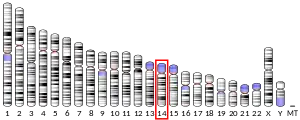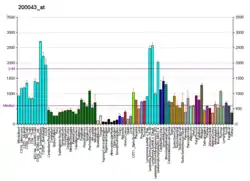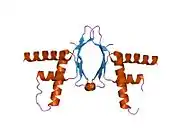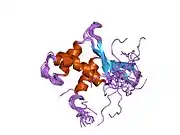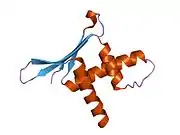| ERH | |||||||||||||||||||||||||||||||||||||||||||||||||||
|---|---|---|---|---|---|---|---|---|---|---|---|---|---|---|---|---|---|---|---|---|---|---|---|---|---|---|---|---|---|---|---|---|---|---|---|---|---|---|---|---|---|---|---|---|---|---|---|---|---|---|---|
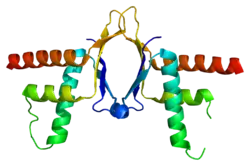 | |||||||||||||||||||||||||||||||||||||||||||||||||||
| |||||||||||||||||||||||||||||||||||||||||||||||||||
| Identifiers | |||||||||||||||||||||||||||||||||||||||||||||||||||
| Aliases | ERH, DROER, enhancer of rudimentary homolog (Drosophila), mRNA splicing and mitosis factor, ERH mRNA splicing and mitosis factor | ||||||||||||||||||||||||||||||||||||||||||||||||||
| External IDs | OMIM: 601191 MGI: 108089 HomoloGene: 3274 GeneCards: ERH | ||||||||||||||||||||||||||||||||||||||||||||||||||
| |||||||||||||||||||||||||||||||||||||||||||||||||||
| |||||||||||||||||||||||||||||||||||||||||||||||||||
| |||||||||||||||||||||||||||||||||||||||||||||||||||
| |||||||||||||||||||||||||||||||||||||||||||||||||||
| |||||||||||||||||||||||||||||||||||||||||||||||||||
| Wikidata | |||||||||||||||||||||||||||||||||||||||||||||||||||
| |||||||||||||||||||||||||||||||||||||||||||||||||||
| Enhancer of rudimentary | |||||||||
|---|---|---|---|---|---|---|---|---|---|
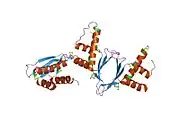 crystal structure of enhancer of rudimentary homologue (erh) | |||||||||
| Identifiers | |||||||||
| Symbol | ER | ||||||||
| Pfam | PF01133 | ||||||||
| InterPro | IPR000781 | ||||||||
| PROSITE | PDOC00732 | ||||||||
| SCOP2 | 1j24 / SCOPe / SUPFAM | ||||||||
| TCDB | 3.A.16 | ||||||||
| |||||||||
In molecular biology, Enhancer of rudimentary homolog is a protein that in humans is encoded by the ERH gene.[5][6][7]
The Drosophila protein enhancer of rudimentary protein is a small protein of 104 amino acids. It has been found to be an enhancer of the rudimentary gene, involved in pyrimidine biosynthesis.[8]
From an evolutionary point of view, enhancer of rudimentary is highly conserved and has been found to exist in probably all multicellular eukaryotic organisms.[6] It has been proposed that this protein plays a role in the cell cycle.
References
- 1 2 3 GRCh38: Ensembl release 89: ENSG00000100632 - Ensembl, May 2017
- 1 2 3 GRCm38: Ensembl release 89: ENSMUSG00000021131 - Ensembl, May 2017
- ↑ "Human PubMed Reference:". National Center for Biotechnology Information, U.S. National Library of Medicine.
- ↑ "Mouse PubMed Reference:". National Center for Biotechnology Information, U.S. National Library of Medicine.
- ↑ Isomura M, Okui K, Fujiwara T, Shin S, Nakamura Y (Sep 1996). "Cloning and mapping of a novel human cDNA homologous to DROER, the enhancer of the Drosophila melanogaster rudimentary gene". Genomics. 32 (1): 125–7. doi:10.1006/geno.1996.0086. PMID 8786099.
- 1 2 Gelsthorpe M, Pulumati M, McCallum C, Dang-Vu K, Tsubota SI (Apr 1997). "The putative cell cycle gene, enhancer of rudimentary, encodes a highly conserved protein found in plants and animals". Gene. 186 (2): 189–95. doi:10.1016/S0378-1119(96)00701-9. PMID 9074495.
- ↑ "Entrez Gene: ERH enhancer of rudimentary homolog (Drosophila)".
- ↑ Wojcik, E.; Murphy, A. M.; Fares, H.; Dang-Vu, K.; Tsubota, S. I. (1994). "Enhancer of rudimentaryp1, e(r)p1, a highly conserved enhancer of the rudimentary gene". Genetics. 138 (4): 1163–1170. doi:10.1093/genetics/138.4.1163. PMC 1206255. PMID 7896098.
Further reading
- Strausberg RL, Feingold EA, Grouse LH, et al. (2003). "Generation and initial analysis of more than 15,000 full-length human and mouse cDNA sequences". Proc. Natl. Acad. Sci. U.S.A. 99 (26): 16899–903. Bibcode:2002PNAS...9916899M. doi:10.1073/pnas.242603899. PMC 139241. PMID 12477932.
- Gerhard DS, Wagner L, Feingold EA, et al. (2004). "The Status, Quality, and Expansion of the NIH Full-Length cDNA Project: The Mammalian Gene Collection (MGC)". Genome Res. 14 (10B): 2121–7. doi:10.1101/gr.2596504. PMC 528928. PMID 15489334.
- Andersen JS, Lam YW, Leung AK, et al. (2005). "Nucleolar proteome dynamics". Nature. 433 (7021): 77–83. Bibcode:2005Natur.433...77A. doi:10.1038/nature03207. PMID 15635413. S2CID 4344740.
- Amente S, Napolitano G, Licciardo P, et al. (2005). "Identification of proteins interacting with the RNAPII FCP1 phosphatase: FCP1 forms a complex with arginine methyltransferase PRMT5 and it is a substrate for PRMT5-mediated methylation". FEBS Lett. 579 (3): 683–9. doi:10.1016/j.febslet.2004.12.045. PMID 15670829. S2CID 33475235.
- Wan C, Tempel W, Liu ZJ, et al. (2005). "Structure of the conserved transcriptional repressor enhancer of rudimentary homolog". Biochemistry. 44 (13): 5017–23. doi:10.1021/bi047785w. PMID 15794639.
- Stelzl U, Worm U, Lalowski M, et al. (2005). "A human protein-protein interaction network: a resource for annotating the proteome". Cell. 122 (6): 957–68. doi:10.1016/j.cell.2005.08.029. hdl:11858/00-001M-0000-0010-8592-0. PMID 16169070. S2CID 8235923.
- Ewing RM, Chu P, Elisma F, et al. (2007). "Large-scale mapping of human protein–protein interactions by mass spectrometry". Mol. Syst. Biol. 3 (1): 89. doi:10.1038/msb4100134. PMC 1847948. PMID 17353931.
- Jin T, Guo F, Serebriiskii IG, et al. (2007). "A 1.55 A resolution X-ray crystal structure of HEF2/ERH and insights into its transcriptional and cell-cycle interaction networks". Proteins. 68 (2): 427–37. doi:10.1002/prot.21343. PMID 17444515. S2CID 2003248.
External links
- PDBe-KB provides an overview of all the structure information available in the PDB for Human Enhancer of rudimentary homolog (ERH)
- PDBe-KB provides an overview of all the structure information available in the PDB for Mouse Enhancer of rudimentary homolog (ERH)
This article is issued from Wikipedia. The text is licensed under Creative Commons - Attribution - Sharealike. Additional terms may apply for the media files.
